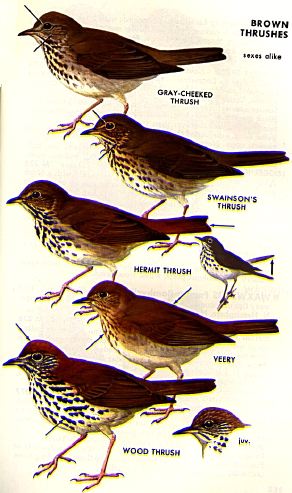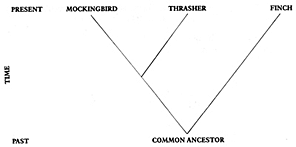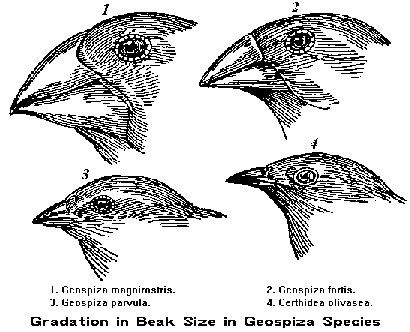| Speciation |
|
|
| |
|
|
| |
| "Every species is a cousin of every other. Any two species are descended from an ancestral species, which split in two." |
| |
|
Richard Dawkins. p. 254 |
| |
|
| "Biologists use the word 'speciation' for the splitting of a species into two daughter species." |
|
|
Dawkins. pp. 256-257 |
|
 |
A species is any group of breeding populations capable of producing reproductively viable offspring. In a genetic sense they share a common gene pool. That means there has been no chromosomal reorganization of inheritable material that might create an isolating mechanism that would render offspring of distant relatives sterile–that is unable to reproduce.
A further discussion by Mayr
Here five distinct species of thrushes are distinuishable. |
| |
|
birds | speciation
| peripatric speciation | Mayr
| Dawkins
|
Birds
 Fascinating results have emerged from these DNA-DNA hybridization studies. Sibley and Ahlquist's tens of thousands of DNA-DNA hybrid comparisons have revealed that each of two close relatives, say, a mockingbird and a thrasher, show the same genetic distance from a third less-related bird.
Fascinating results have emerged from these DNA-DNA hybridization studies. Sibley and Ahlquist's tens of thousands of DNA-DNA hybrid comparisons have revealed that each of two close relatives, say, a mockingbird and a thrasher, show the same genetic distance from a third less-related bird.
A cladogram of three relative species. 
For example, a mockingbird and a thrasher each form hybrid DNA with a finch that melts at roughly the same temperature. This means that the genetic distance between evolving bird species with the same generation time (e.g., passerines, which all mature at one year) always increases at roughly the same rate.
Both the mocker and thrasher must have been separated for the same amount of time from the last common ancestor the two shared with the finch.
Speciation: or the emergence of two species where there once was only one.
The emergence of species, that is the separation of one interbreeding population into two separate –non cross-breeding– populations, is a difficult concept to pin down because it arises from the behavior of animals and the polyploidy capability widely shared by plants, but not other organisms.
Bacteria for example are quite different from plants and animals with respect to genetic transfer, variability and sexual reproduction.
Species according to the late Ernst Mayr is the "holy grail" of biological investigation. This is partially so because of genetic research into both chromosomal clocks and epigenetic methylation that occurs along strands of DNA. But there are other reasons to consider that species and speciation is a difficult universal concept and not well understood process in the living world.
Mayr wrote "One might presume that everything about the origin of new species is understood," but he cautioned "this is not the case," even "a century and a quarter after the publication of the Origin of Species." (p. 359)
"In higher animals and in most groups of plants, speciation is populational, that is, a more or less isolated population becomes a new species through genetic restructuring." (Ibid.)
"It must never be forgotten during the analysis of processes of speciation that a number of different processes occur simultaneously and that it leads to a misunderstanding to pose the question of either / or." (p. 360)
"The observation that the comparison of enzyme genes of closely related species sometimes fails to reveal any difference whatsoever confirms the possibility that relatively few genes may be involved in certain speciation events." (p. 362)
"on the other hand, peripatric speciation (isolating mechanisms make reproduction impossible) in a small founder population provides the opportunity for a drastic and rather rapid genetic restructuring."
Peripatric speciation
"Here, the gene pool of a small either founder or relict (remaining) population is rapidly, and more or less drastically, reorganized, resulting in the quick acquisition of isolating mechanisms and usually also in drastic morphological modifications and ecological shifts. It involves populations that pass through a bottleneck in population size." (p. 367)
Evidence:
A "group of birds which shows hardly any geographic variation on the mainland of New Guinea over a distance of more than 1,000 kilometers and with a distribution over several climatic zones and across several geographical barriers, where as all populations on islands off New Guinea (for example, Koffiao, Biak, Numfor) are so strikingly different that they were considered to be separate species."
"each of these islands, none of which could have been in recent continental connection with New Guinea, was certainly colonized by a founding pair of birds, giving rise to a highly distinct population." (p. 367)
Sources
Ernst Mayr, Toward a New Philosophy of Biology: Observations of an Evolutionist. Cambridge: Harvard University Press, 1988.
The Development of Biological Thought, 1982.
Richard Dawkins, The Greatest Show On Earth. New York: Free Press, 2009, pp. 254-260.
What do geneticists mean by
• polyploidy, the duplication (usuallly in plants and some fungus and even a few animals) of the chromosome such that a copy exists, hence a doubling of the chromosomal material available to pass on to offspring.
• methylation?
Introduction to DNA methylation
After every cycle of DNA replication, several modifications occur in the DNA. DNA methylation is one such post-synthesis modification. DNA methylation has been proven by research to be manifested in a number of biological processes such as regulation of imprinted genes, X chromosome inactivation, and tumor suppressor gene silencing in cancerous cells. It also acts as a protection mechanism adopted by the pathogen DNA (mainly bacterial against the endonuclease activity that destroys any foreign DNA.
DNA methylation mechanism
In DNA, methylation usually occurs in the CpG islands, a CG rich region–that is an locus where cytosine and guanine are more common than not–, upstream of the promoter region. The letter “p” here signifies that the C (cytosine) and G (Guanine) are connected by a phosphodiester bond.
In humans, DNA methylation is carried out by a group of enzymes called DNA methyltransferases. These enzymes not only determine the DNA methylation patterns during the early development, but are also responsible for copying these patterns to the strands generated from DNA replication.
http://www.premierbiosoft.com/molecular_beacons/dna-methylation/index.html
The Role of Methylation in Gene Expression
By: Theresa Phillips, Ph.D. (Write Science Right) © 2008 Nature Education
Citation: Phillips, T. (2008) The role of methylation in gene expression. Nature Education 1(1)
Not all genes are active at all times. DNA methylation is one of several epigenetic mechanisms that cells use to control gene expression.
There are many ways that gene expression is controlled in eukaryotes, but methylation of DNA (not to be confused with histone methylation) is a common epigenetic signaling tool that cells use to lock genes in the "off" position. In recent decades, researchers have learned a great deal about DNA methylation, including how it occurs and where it occurs, and they have also discovered that methylation is an important component in numerous cellular processes, including embryonic development, genomic imprinting, X-chromosome inactivation, and preservation of chromosome stability.
Given the many processes in which methylation plays a part, it is perhaps not surprising that researchers have also linked errors in methylation to a variety of devastating consequences, including several human diseases.
See– Mayr, 1982
http://www.nature.com/scitable/topicpage/the-role-of-methylation-in-gene-expression-1070

genes | speciation | diversity | descent
Mayr | Thomas | Wilson | Hardin | Darwin | Margulis | Steingraber | Tattersall | Carr | Keller | Watson
Genetics Index | What makes genetics significant? | History of Genetics | DNA discovery | RNA | Resistance | Visual images



